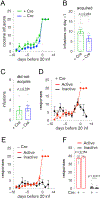β2* nAChR sensitivity modulates acquisition of cocaine self-administration in male rats
- PMID: 38508306
- PMCID: PMC10994757
- DOI: 10.1016/j.neuropharm.2024.109927
β2* nAChR sensitivity modulates acquisition of cocaine self-administration in male rats
Abstract
Signaling through nicotinic acetylcholine receptors (nAChRs) plays a role in cocaine reward and reinforcement, suggesting that the cholinergic system could be manipulated with therapeutics to modulate aspects of cocaine use disorder (CUD). We examined the interaction between nAChRs and cocaine reinforcement by expressing a hypersensitive β2 nAChR subunit (β2Leu9'Ser) in the ventral tegmental area of male Sprague Dawley rats. Compared to control rats, β2Leu9'Ser rats acquired (fixed ratio) intravenous cocaine self-administration faster and with greater likelihood. By contrast, β2Leu9'Ser rats were approximately equivalent to controls in their intake of cocaine on a progressive ratio schedule of reinforcement, suggesting differential effects of cholinergic signaling depending on experimental parameters. Like progressive ratio cocaine SA, β2Leu9'Ser rats and controls did not differ significantly in food SA assays, including acquisition on a fixed ratio schedule or in progressive ratio sessions. These results highlight the specific role of high-affinity, heteropentameric β2* (β2-containing) nAChRs in acquisition of cocaine SA, suggesting that mesolimbic acetylcholine signaling is active during this process.
Copyright © 2024 Elsevier Ltd. All rights reserved.
Conflict of interest statement
Declaration of competing interest None.
Figures





Similar articles
-
Expression of sensitized β2 nAChR subunits in VTA neurons enhances intravenous nicotine self-administration in male rats.Neuropharmacology. 2024 Dec 15;261:110161. doi: 10.1016/j.neuropharm.2024.110161. Epub 2024 Sep 17. Neuropharmacology. 2024. PMID: 39299573
-
β2 nAChR Activation on VTA DA Neurons Is Sufficient for Nicotine Reinforcement in Rats.eNeuro. 2023 May 25;10(5):ENEURO.0449-22.2023. doi: 10.1523/ENEURO.0449-22.2023. Print 2023 May. eNeuro. 2023. PMID: 37193602 Free PMC article.
-
Self-administration of 5-iodo-A-85380, a beta2-selective nicotinic receptor ligand, by operantly trained rats.Neuroreport. 2003 Aug 6;14(11):1503-5. doi: 10.1097/00001756-200308060-00020. Neuroreport. 2003. PMID: 12960773
-
Recent advances in understanding nicotinic receptor signaling mechanisms that regulate drug self-administration behavior.Biochem Pharmacol. 2011 Oct 15;82(8):984-95. doi: 10.1016/j.bcp.2011.06.026. Epub 2011 Jun 29. Biochem Pharmacol. 2011. PMID: 21740894 Free PMC article. Review.
-
Involvement of cholinergic neuronal systems in intravenous cocaine self-administration.Neurosci Biobehav Rev. 2004 Jan;27(8):841-50. doi: 10.1016/j.neubiorev.2003.11.002. Neurosci Biobehav Rev. 2004. PMID: 15019433 Review.
Cited by
-
Expression of sensitized β2 nAChR subunits in VTA neurons enhances intravenous nicotine self-administration in male rats.Neuropharmacology. 2024 Dec 15;261:110161. doi: 10.1016/j.neuropharm.2024.110161. Epub 2024 Sep 17. Neuropharmacology. 2024. PMID: 39299573
References
-
- Administration, S.A.a.M.H.S., Key Substance Use and Mental Health Indicators in the United States: Results from the 2017 National Survey on Drug Use and Health. 2018, Center for Behavioral Health Statistics and Quality, Substance Abuse and Mental Health Services Administration: Rockville, MD.
-
- Hedegaard H, et al., Drugs Most Frequently Involved in Drug Overdose Deaths: United States, 2011–2016. Natl Vital Stat Rep, 2018. 67(9): p. 1–14. - PubMed
-
- Budney AJ, et al., Nicotine and caffeine use in cocaine-dependent individuals. J Subst Abuse, 1993. 5(2): p. 117–30. - PubMed
-
- Reid MS, et al., An acute dose of nicotine enhances cue-induced cocaine craving. Drug Alcohol Depend, 1998. 49(2): p. 95–104. - PubMed
MeSH terms
Substances
Grants and funding
LinkOut - more resources
Full Text Sources

